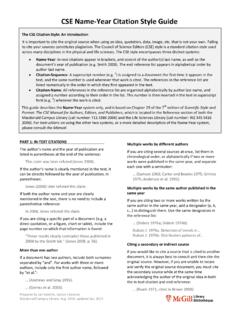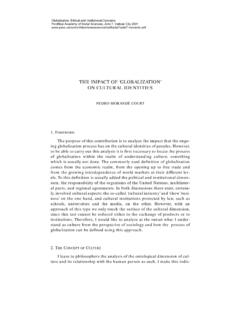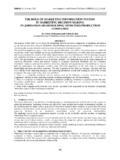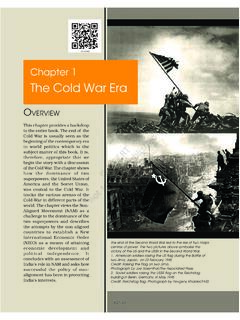Transcription of 2.0. Community Participation - McGill University
1 11 Community Participation Definition The focus of this chapter is to provide an explanation for the term Community Participation , a concept central to this research report. The definitions presented by various theorists have been presented in an effort to give a comprehensive overview of the term. Following closely the definition of Community Participation , are also discussed critical issues related to it such as the stages and levels of Participation and the need for it. Participation does not necessarily imply self-help home building by undernourished and over-worked people without credit, with inadequate tools and poor materials.
2 The central issue is that of control and power to decide. John Turner in Housing by People (133). The discussion of Community Participation in architecture, first initiated in the 1960s, became a buzzword in mid-1970s after the sites and services housing schemes received funding and acceptance by the World Bank in the developing countries (Hamdi, Housing 76). However, it is important to understand the meaning of Community Participation as it has been misused and abused in many projects claiming to have Community Participation as a project component. First understanding the meanings of the words Community and Participation individually can best explain the term Community Participation .
3 Nick Wates defines the word Community in The 12 Community Planning Handbook, as a group of people sharing common interests and living within a geographically defined area (184). Nabeel Hamdi in his book (with Reinhard Goethert), Action Planning for Cities: A Guide to Community Practice, points out that the term Community has both social and spatial dimensions and that generally the people within a Community come together to achieve a common objective, even if they have certain differences (Hamdi, Action 67). The concept of a Community works on the age old principles of unity is strength and united we stand . A group of people always has advantage over a single individual in getting his or her voice heard, especially in the case of have-nots of the society.
4 Charles Abrams in his book, The Language of Cities: A Glossary of Terms, defines Community as, that mythical state of social wholeness in which each member has his place and in which life is regulated by cooperation rather than by competition and conflict (60). It is clear that a Community generally has two certain elements, that is, physical boundaries and social interests common among the people. On the other hand, a Community sometimes may have one element dominating the other, for example, a Community Box 1. Charles Abrams Born in 1902, Charles Abrams made pioneering contributions to the area of housing trends and land issues in both the developing and developed world through his numerous books including, The Future of Housing (1946), Forbidden Neighbors: A Study of Prejudice in Housing (1955), Housing in the Modern World (1964), Man s Struggle for Shelter in an Urbanizing World (1964), The City is the Frontier (1965) and The Language of Cities: A Glossary of Terms (1971).
5 He also held teaching positions at Columbia University and MIT as well as being an advisor and consultant for the United Nations, the Agency for International Development and several governments worldwide (Abrams, City 395). 13 of students or a Community of artists generally need not belong to the same physical boundaries. In this case, they come together on certain ideological grounds. Nabeel Hamdi presents an opposing view that the communities are not necessarily always organized and cohesive and sometimes lack the sense of Community and social identity (Hamdi, Action 67). He explains that for Community participatory projects, it is not a must to have an already well organized Community right from the beginning but the sense of Community can be achieved during the course of the project, which can also be one of the objectives of including Community Participation in development projects (Hamdi, Action 67).
6 Charles Abrams gives a good example of the sense of Community in the case of people living in a squatter settlement. These squatters, living within the confines of the same settlement, have common objectives and work together to protect and legalize their dwellings. Their survival against the authorities rests upon Box 2. Nick Wates Born in 1951, Nick Wates is one of the world s leading consultants of Community planning and architecture. He received his professional training in architecture and planning from University College London in 1975 and has been involved in research, writing, consultancy and the practice of Community planning for a good 25 years.
7 His major literary contributions include, The Battle for Tolmers Square (1976), Squatting, the Real Story (1980), Community Architecture (with Charles Knevitt 1987), Action Planning (1996) and The Community Planning Handbook (2000). His firm Nick Wates Associates offers various design, training and research services at both the national and international levels. He currently resides in Hastings, England (Nick). Photo from Nick Wates, 2000: 230. 14 cooperation among them and hence, the sense of Community is strengthened by their common goals. Compare this with the generally non-existent sense of Community among the residents of a posh neighborhood with the best physical form of housing (Abrams, Language 203).
8 The word Participation can be defined as the [a]ct of being involved in something (Wates, Handbook 194). According to Habraken, Participation has two definitions with opposite meanings. Participation can either represent assigning certain decisive roles to the users, where they share the decision - making responsibility with the professionals. The other type of Participation is where there is no shift of responsibilities between the users and professionals but instead only the opinion of the user is considered while making decisions (Habraken, Towards 139). Community Participation means some form of involvement of people, with similar needs and goals, in decisions affecting their lives.
9 Charles Abrams defines Community Box 3: Nabeel Hamdi Trained as an architect, Nabeel Hamdi has been involved in several research and consultancy projects in both the developing and the developed countries of the world. He was the architect of 1970s widely acclaimed, Community -based PSSHAK housing projects in London and is the recipient of several awards for his contributions. Hamdi also held a teaching position for 10 years at MIT, US and is currently the Co-Director of the Centre for Development and Emergency Practice and the Director of Housing and Urban Development at Oxford Brookes University , UK. He has authored 4 books which include: making Micro Plans: A Community Based Process in Programme making and Development (1988); Housing Without Houses: Participation , Flexibility, Enablement (1991); Educating for Real: The Training of Professionals for Development Practices (1996), Action Planning for Cities: A Guide to Community Practice (with Reinhard Goethert 1997) (Centre for Development).
10 Photo from DFID, Removing. 15 Participation as, [t]he theory that the local Community should be given an active role in programs and improvements directly affecting it (63). It is only rational to give control of affairs and decisions to people most affected by them. Besides, since no government or authority has the means to solve all the public problems adequately, it is necessary to involve people in matters that affect them (Abrams, Language 63). However, delegating powers to people is not an easy task and involves great inquiry into the change in the attitudes of the authorities and professionals, which is addressed in the next section.















